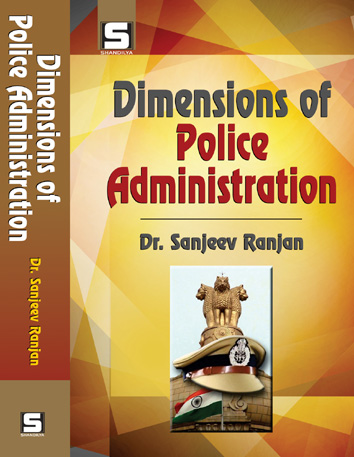Categories of the Books
- Police Administration
- Women Studies
- 2024
- Sociology
- Science
- Biography
- 2025
- Botony
- Food Science
- 2023
- 2022
- 2021
- 2020
- 2019
- 2018
- 2017
- Dr. Debesh Bhowmik
- Agriculture
- Banking
- Covid-19
- Dalits
- Economics
- Education
- Education & Gender
- Environment
- Finance
- Hindi
- History
- Human Rights
- Gandhian Studies
- GST
- Geography
- Insurance
- Law
- Literature
- Migration
- Military Studies
- Military Law
- Mass Media
- Commerce
- Management
- New Books
- NREGA
- Public Administration
- Politics
- Share Market
- Social Work
- Tourism
- Tribes
- Women & Children Studies
- Forthcoming
- Uncategorized
Book & Detail
Dimensions of Police Administration
-

Author : Sanjeev Ranjan Year of Publication : 2025 ISBN : 9789393934093 Language : English Binding : Hard Bound Pages : 548 Size : 26 cms (Royal Size) Categories : 2025, Police Administration, Law, New Books Price : 2000
FREE HOME DELIVERY
About the Book
Dimensions of Police Administration offers a comprehensive and multi-faceted examination of the policing system in India. It traces the historical evolution of police institutions, unpacks their legal and administrative frameworks, and critically engages with contemporary challenges and reform imperatives. Designed as a foundational resource, the book is intended for students, researchers, policymakers, law enforcement professionals, and civil society actors seeking to understand and engage with the complexities of police governance in a democratic society. The book begins by establishing the scope, objectives, and significance of police administration, situating the role of the police within the broader context of constitutional democracy. It provides a systematic analysis of statutory mandates and the functional evolution of police institutions, with detailed discussions on the Police Act of 1861, the Model Police Act of 2006, and the Code of Criminal Procedure, 1973. It also highlights region-specific innovations, such as community policing initiatives and structural reforms in states like Punjab, Haryana, and Himachal Pradesh. The historical development of policing is explored across ancient, medieval, colonial, and post-independence India, with a critical focus on reform initiatives, judicial interventions, and the persistent barriers posed by political interference and institutional inertia.
Further chapters delve into the roles, powers and organizational structures of central police agencies, including the CBI, NCRB, IB, and BPR&D, as well as Central Armed Police Forces (CAPFs) like the CRPF, BSF, CISF, ITBP, and others. The growing representation of women in paramilitary forces and the legal frameworks governing these bodies are given due emphasis. A significant section is devoted to police investigations, including procedural and ethical aspects of FIR registration, arrest, detention, and charge sheet preparation, with particular focus on the interrogation of vulnerable groups—women and children—supported by legal safeguards and model rules under the Juvenile Justice Act, 2015. The book explores the complex relationship between crime and policing, reviewing crime categories such as crimes against women and children, custodial deaths, organized crime, and narcotics control. Key legislative reforms, including the Criminal Law (Amendment) Acts of 2013 and 2018 and state-specific laws like the Disha Bill (Andhra Pradesh), Shakti Bill (Maharashtra), and Aparajita Bill (West Bengal), are critically evaluated. It also addresses state and district-level policing, prison administration, and issues related to overcrowded facilities and undertrial populations, supported by the Model Prison Manual. A standout feature is its empirical analysis of NCRB crime data from 2012 to 2022, offering statistical insights into crimes against women, cybercrime, economic offenses, juvenile delinquency, and narcotics-related offenses. The book further clarifies legal distinctions between “law and order” and “public order” through recent Supreme Court judgments. Overall, Dimensions of Police Administration stands as a rigorous, data-driven, and reform-oriented work that not only maps the institutional and procedural dimensions of Indian policing but also advocates for gender sensitivity, transparency, and evidence-based policymaking to enhance public accountability and trust in law enforcement.
About the Author
Dr. Sanjeev Ranjan, M.A., Ph.D. (Public Administration), Post Graduate Diploma in Forensic Science & Criminology, M.A. in Police Administration (Gold Medalist), LL.B. (2020), LL.M. (2021) and currently pursuing a Ph.D. in Laws from the Department of Laws, Panjab University, Chandigarh, is an Assistant Professor of Police Administration at the Department of Evening Studies, Multi-Disciplinary Research Centre (M.D.R.C.), Panjab University, Chandigarh.
He has 14 years teaching experience to his credit. Dr. Ranjan has published 22 research papers in national and international journals as well as in a book and he is a sole author of the book title “Municipal Administration in Haryana” and Book title “Police Administration: Concept and Practices”, “Police Personnel Administration: A Case Study of Chandigarh Police” and Co-author Book title “Human Resource Management in Solid Waste: A Case Study of Chandigarh”.
Dr. Ranjan has attended 45 national seminars, conferences, and workshops, and has presented 38 research papers.

